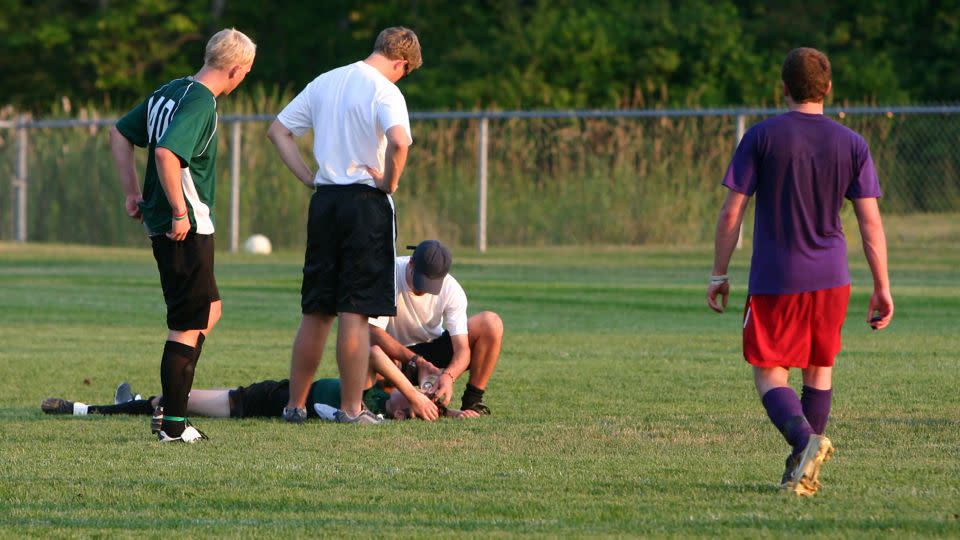How to avoid, identify and treat concussions

Editor’s note: Season 8 of the podcast Chasing Life with Dr. Sanjay Gupta gets back to basics with an in-depth examination of the brain in different states. Each episode will focus on one of those states — the distracted brain, the frightened brain, the nourished brain and more — to spotlight what’s going on in our heads and how it affects our bodies.
(CNN) — Doctors, researchers and laypeople have come a long way in the understanding of concussions. Once comic fodder depicted as cartoon characters seeing stars, the condition is finally getting the attention it deserves, with strict concussion protocols in place in amateur and professional organized sports.
According to the US Centers for Disease Control and Prevention, a concussion happens after a “bump, blow, or jolt to the head” or “a hit to the body that causes the head and brain to move quickly back and forth.” Any of these sudden movements can cause “the brain to bounce around or twist in the skull,” “chemical changes in the brain” and/or the “stretching and damaging” of brain cells, the CDC says.
The changes can lead to symptoms, such as feeling dizzy or disoriented in the moment, or longer-lasting issues with sleep, memory, learning and even personality changes.
And far from being something to brush off lightly, concussions are classified as traumatic brain injuries, Julie Stamm, author of the book “The Brain on Youth Sports: The Science, the Myths, and the Future,” told CNN Chief Medical Correspondent Dr. Sanjay Gupta on the podcast Chasing Life.
“I often use the term concussion because it’s just so commonly used in sport especially. But it is a traumatic brain injury, and it’s often classified as a mild traumatic brain injury — and even that feels like it minimizes the injury,” said Stamm, a clinical assistant professor in the department of kinesiology at the University of Wisconsin-Madison.
“We’re not worried about somebody having bleeding on the brain and having it be a critical, life-threatening thing in that moment. But it still can have very significant consequences, lasting symptoms, and can very much disrupt someone’s life. So, it is a serious injury.”
Concussions can happen when playing youth or professional sports, but they can also be the result of falls, motor vehicle accidents, military injuries and assaults, including intimate partner violence and child abuse.
It’s hard to pin down the number of concussions that happen annually, because people often don’t seek help, but the University of Pittsburgh Medical Center estimates 1.7 million to 3 million sports- and recreation-related concussions occur each year — half of which go unreported or undetected. That estimate doesn’t even count concussions from other causes.
Repeated head injuries can increase the risk of developing chronic traumatic encephalopathy, or CTE — a condition associated with memory loss, confusion, impulse control problems, aggression, depression, impaired judgment and suicidal behavior as well as early-onset dementia.
To hear more of the conversation on kids, sports and concussions, listen to the full episode of Chasing Life here:
So, what can you do to protect, identify and treat a concussion? Stamm offers these five tips to raise awareness.
Concussions can happen without losing consciousness
You do not need to lose consciousness to have a concussion, Stamm said via email. “Less than ten percent of concussions result in a loss of consciousness,” she noted.
Concussions can occur without a direct hit to the head
Similarly, a concussion can occur in the absence of a direct hit to the head. “A blow to the body that causes the head to move back and forth, like whiplash, can cause a concussion because the brain moves within and hits against the skull,” Stamm said, explaining that in sports, “This is one reason why helmets cannot prevent all concussions.”
Don’t overlook less obvious concussion symptoms
Confusion, dizziness or balance issues, and a dazed appearance are all signs and symptoms of a concussion, Stamm said. But she added that parents and guardians, coaches, and teammates should be on the lookout for common yet overlooked symptoms. “These include difficulty sleeping or not sleeping enough, being apathetic, or being overly emotional,” she said, noting that they might also not show up immediately.
Update your treatment playbook
“While we used to say that rest is best following a concussion, we now know that light exercise is helpful for concussion recovery,” Stamm said. She recommends starting with an easy exercise such as light walking or riding a stationary bike 24 to 48 hours after a concussion. Aim for “a level that either does not — or only mildly — exacerbates symptoms (no more than two points on a 10-point scale),” she wrote, because that “increases blood flow to the brain and can help the brain recover faster.”
Avoid impacts in sports
“Minimizing or eliminating impacts in practice or delaying the start of full-contact versions of sport until a child is older are strategies that not only help to reduce concussion risk, but also to minimize the consequences of repetitive brain trauma in sports,” Stamm said. “The best way to prevent a concussion is to avoid impacts.”
We hope these five tips help protect your (or a loved one’s) brain in case of a concussion. Listen to the full episode here. And join us next week when we break with regular Chasing Life programming for a special episode of Paging Dr. Gupta on the mental effects of watching a war unfold in real time, and how to speak to kids about what is happening in Israel and Gaza.
CNN Audio’s David Rind contributed to this report.
For more CNN news and newsletters create an account at CNN.com

